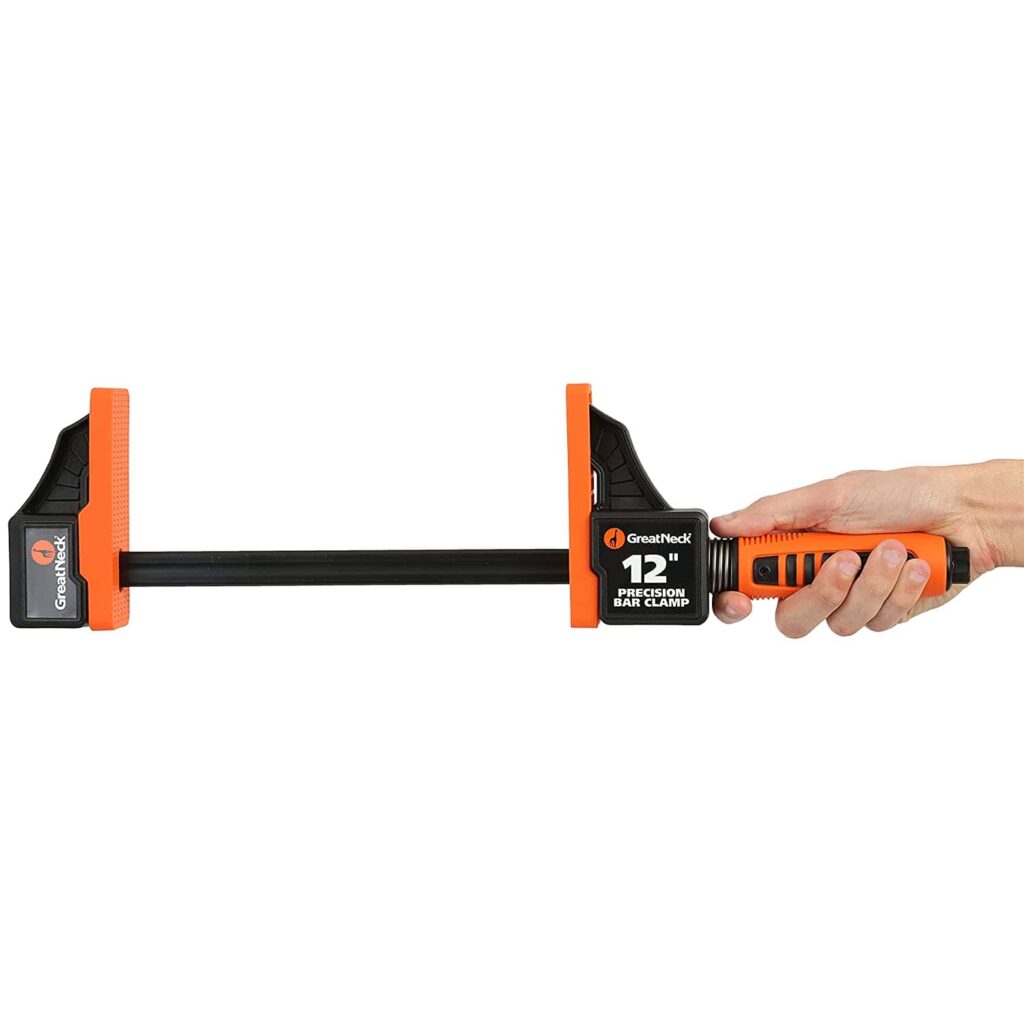Let’s face it! Choosing the right clamp for your desired woodworking project may appear to be challenging, especially if you don’t have much idea about it!
Today’s topic on pipe clamps vs. bar clamps will give you a clear guideline by showing their common differences, functionalities, and their best uses.
What is the Difference Between A Pipe Clamp and Bar Clamp?
Despite having some similarities, you can notice a few differences while comparing a bar clamp and a pipe clamp. Let’s have a quick look out there:
Difference in Attachment
The very first thing you may find differences between these two clamps is the way of attachment.
A bar clamp generally features a specific head that aids in attaching teeth to the wood. In comparison, the head of a pipe clamp plays a role in sliding into the wood.
Variation in the Usability
The majority of woodworking experts tend to use pipe clamps in terms of holding wood together while finishing. On the flip side, bar clamps are known for attaching two wood pieces at once.
Moreover, they’re suitable for clamping the wood, especially when you varnish or glue it.
Versatility
Although pipe clamp earns lots of fame in industrial settings, bar clamps tend to be more versatile. Ask me how. You’ll find them way better than pipe clamps while dealing with several applications like cabinet projects, tabletop, and so on!
Availability
While purchasing pipe clamps, you’ll need to get them in sets. In contrast, bar clamps are available in numerous materials and styles. And you won’t have to purchase a complete set.
Are Pipe Clamps as Good as Bar Clamps?
Talking about functionality and overall performance, both pipe clamps, and bar clamps earn gold standards. Each of them comes in handy regarding the attachment process, usability, and availability.
But when it comes down to multi-functionality, a pipe clamp is unfortunately not as good as a bar clamp because pipe clamps can only do the task of holding wood together for finishing; bar clamps can be used for multiple woodworking projects.
Pipe Clamp

Let’s find out the common uses of a pipe clamp, including why it works and its common problems of it.
What is Pipe Clamp Used for?
Around industrial settings, pipe clamps assist in holding wood pieces together in terms of joining or finishing.
Manufactured with premium aluminum and steel, it generally features a hollow tube on the clamp’s head. Unlike bar clamps, it is easier to use on flat, smooth wood.
How did Pipe Clamp Kits work?
In general, a pipe clamp performs its work by firmly fastening the pipe. Afterward, it suspends the pipe from a rail system or surface. Pipe clamps play a significant role in locking the pipe, clamping it in a specific spot so that it gets well-secured.
Although the current market features a couple of different pipe clamps like the standard, traditional, plastic, and heavy-duty, most of them work almost in the same manner.
Avoiding Common Problems with Pipe Clamps
Many people mistake choosing the wrong clamps to fill their desired requirements. So let’s find out what are the common problems you may avoid if you get the pipe clamps:
- Don’t utilize pipe clamps on the wood’s flat and smooth surface. Instead, go for the bar clamp for this particular task.
- The market has several types of clamps. So you better do some study on them and then get the one that is ideal for your projects.
- If a cheap clamp can do the task you want to complete, there is no need to spend a fortune on a high-end pipe clamp.
Bar Clamp

Please look at how you can use bar clamps woodworking, its basic uses, and its common problems.
What is Bar Clamp Used for?
The project regarding metalworking and woodworking may require the usage of bar clamps. They assist in keeping mid-to-large metal or wood firmly in a particular spot to let them get jointed permanently.
You’ll find three types of bar clamps around the shop to deal with several projects, such as sash clamps, t-bar, and pipe clamps.
How Do You Use Bar Clamps Woodworking?
Make sure to follow each point to learn the way of using bar clamps woodworking –
- Choose a suitable space for setting the clamp, which can be either a table or bench top.
- Opening the jaws is what you’ll do now by turning around each screw.
- Slightly press the lever in a downward position.
- Either spray the bar or place a piece of paper wax to protect the workpiece.
- Get your hands on the workpiece in terms of putting it in the jaws you’ve opened.
- Rotating screws in the right direction is your next task in order to close the jaws.
- Continue rotating till you can feel the workpiece gets well-secured.
Expert Advice: Avoid over-tightening the screws to eliminate the risk of bending the bar, splitting the wood, or any damage.
Common Problems with Bar Clamps
Here are some of the problems you may face with your bar clamp:
- While making attachments, bar clamps need lots of extra effort or strength.
- A few types of bar clamps may cost you a pretty penny.
Frequently Asked Questions (F.A.Q):
In a word, an edge clamp is suitable for holding small or such parts in terms of gluing. Like other clamps, it also comes in several styles.
From plumbing to metalworking to woodworking, pipe clamps are pretty good for all. In fact, many carpenters these days love to rely on it for holding wood together while finishing
Last Words!
The battle of pipe clamps vs. bar clamps was quite head-to-head, which I’ve shown you through this article. Make sure to choose the right one that matches your particular task regarding metalworking or woodworking.
And don’t forget to read the manual of your purchased product, making the best use of it!

I am Imtiaj Islam. I am a wood working enthusiast, having 6 years of experience in carpentry work. I have a BBA graduate degree from Chittagong College. I got vocational training on wood works from Korean Polytechnic out of the quest and zest he has for carpentry as well. I take several wood projects and keep testing different woodworking tools for comfortable and perfect work. I just love playing with woods and machines.
